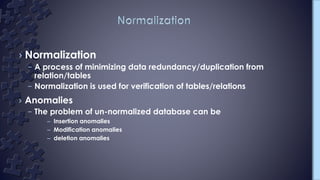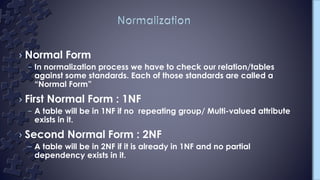Normalization
- 1. Muhammad Umair Oracle Database 11g Developer Track
- 2. âš Normalization â A process of minimizing data redundancy/duplication from relation/tables
- 3. âš Simple Dependency/ Functional Dependency â All attribute are depends on Primary key âš Partial Dependency â Some attribute are dependent on part of primary key âš Transitive Dependency â Dependency of an attribute on Primary key through another attribute âš Multi-valued Dependency â If two or more multi-valued attributes are merged in one relation then that relation will be hold multi-valued dependency
- 4. âš Normalization â A process of minimizing data redundancy/duplication from relation/tables â Normalization is used for verification of tables/relations âš Anomalies â The problem of un-normalized database can be â Insertion anomalies â Modification anomalies â deletion anomalies
- 5. âš Normal Form â In normalization process we have to check our relation/tables against some standards. Each of those standards are called a âNormal Formâ âš First Normal Form : 1NF â A table will be in 1NF if no repeating group/ Multi-valued attribute exists in it. âš Second Normal Form : 2NF â A table will be in 2NF if it is already in 1NF and no partial dependency exists in it.
- 6. âš Third Normal Form : 3NF â A table will be in 3NF if it is already in 2NF and no transitive dependency exists in it. âš Fourth Normal Form : 4NF â A table will be in 4NF if it is already in 3NF and no multi-valued dependency exists in it.






